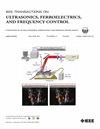High-Volume Acquisition Rate Nonlinear Imaging Enables Robust 3-D Ultrasound Localization Microscopy
IF 3.7
2区 工程技术
Q1 ACOUSTICS
IEEE transactions on ultrasonics, ferroelectrics, and frequency control
Pub Date : 2025-07-16
DOI:10.1109/TUFFC.2025.3589815
引用次数: 0
Abstract
3-D ultrasound localization microscopy (ULM) enables comprehensive mapping of microvascular networks by providing micrometer-scale spatial resolution while avoiding projection errors inherent to 2-D ULM imaging. Current 3-D ULM techniques are based on linear pulse sequences combined with spatiotemporal filtering to distinguish microbubble flow from tissue signals. However, singular-value decomposition (SVD)-based filtering demonstrates poor performance in highly mobile organs, suppressing small vessels with slow blood flow along with tissue signals. While imaging based on nonlinear multipulse sequences can isolate microbubble signals regardless of tissue motion, achieving the high-volume acquisition rates required for 3-D ULM remains technically challenging. Here, we present Fast3D-amplitude modulation (AM) imaging, a 3-D nonlinear imaging sequence that achieves a high-volume acquisition rate (225 Hz) using a single 256-channel ultrasound system with a multiplexed 2-D matrix array. We also introduce a motion rejection algorithm that leverages localized microbubble positions to reject respiratory-induced motion artifacts. Fast3D-AM imaging achieved a superior contrast-to-tissue ratio (CTR) than Fast3D, exhibiting a 6.66-dB improvement in phantom studies. In an in vivo rat study, Fast3D-AM demonstrated higher CTR across all SVD cutoffs compared to Fast3D and preserved both major and microvascular structures in whole-organ kidney imaging.高容量采集率非线性成像使鲁棒三维超声定位显微镜。
三维超声定位显微镜(ULM)通过提供微米尺度的空间分辨率,同时避免2D超声定位显微镜成像固有的投影误差,从而实现微血管网络的全面测绘。目前的三维ULM技术是基于线性脉冲序列结合时空滤波来区分微泡流和组织信号。然而,基于奇异值分解(SVD)的滤波在高流动性器官中表现不佳,会抑制血流缓慢的小血管和组织信号。虽然基于非线性多脉冲序列的成像可以在不考虑组织运动的情况下分离微泡信号,但实现3D ULM所需的高容量采集率在技术上仍然具有挑战性。在这里,我们提出了fast3d调幅(AM)成像,这是一种3D非线性成像序列,使用具有多路复用2D矩阵阵列的单个256通道超声系统实现高容量采集率(225 Hz)。我们还介绍了一种运动抑制算法,该算法利用局部微泡位置来拒绝呼吸引起的运动伪像。与Fast3D相比,Fast3D- am成像获得了更好的组织对比度(CTR),在幻象研究中显示出6.66 dB的改善。在活体大鼠研究中,与Fast3D相比,Fast3D- am在所有SVD截止点上显示出更高的CTR,并且在全器官肾脏成像中保留了主要和微血管结构。
本文章由计算机程序翻译,如有差异,请以英文原文为准。
求助全文
约1分钟内获得全文
求助全文
来源期刊
CiteScore
7.70
自引率
16.70%
发文量
583
审稿时长
4.5 months
期刊介绍:
IEEE Transactions on Ultrasonics, Ferroelectrics and Frequency Control includes the theory, technology, materials, and applications relating to: (1) the generation, transmission, and detection of ultrasonic waves and related phenomena; (2) medical ultrasound, including hyperthermia, bioeffects, tissue characterization and imaging; (3) ferroelectric, piezoelectric, and piezomagnetic materials, including crystals, polycrystalline solids, films, polymers, and composites; (4) frequency control, timing and time distribution, including crystal oscillators and other means of classical frequency control, and atomic, molecular and laser frequency control standards. Areas of interest range from fundamental studies to the design and/or applications of devices and systems.

 求助内容:
求助内容: 应助结果提醒方式:
应助结果提醒方式:


